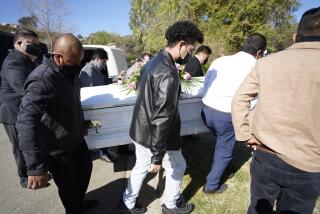American Indians Found Three Times More Likely to Die Young
- Share via
WASHINGTON — American Indians are three times more likely to die young than are other Americans, a new congressional report said Wednesday in finding that Indian health status “still lags behind” the rest of the population.
The 377-page report by Congress’ Office of Technology Assessment said that 37% of deaths among American Indians and Alaska natives occurred before age 45, compared to 12% of all U.S. deaths in the same age group.
Listing causes of death among Indians, the report said that heart disease ranked No. 1, followed by accidents. Indians suffered three times as many accidental deaths as did the rest of the population, the report said. Also, it said, suicides--the ninth leading cause of Indian deaths--were three times greater among Indians aged 15 to 24 than in the rest of the population in that age group.
15 Causes Studied
In all 15 causes of death studied in the report, including pneumonia, liver disease and tuberculosis, Indians died at a higher rate than did other U.S. residents. The report, which covers the period from 1980 to 1982, said that the overall death rate for Indians was 1.4 times that of the general population.
Despite the relatively high death rate, Indians were hospitalized less often than other Americans for several leading causes of death, the report said. This, it added, implies that “access to health care for Indians has decreased.”
Rep. Henry A. Waxman (D-Los Angeles), in a statement accompanying the report, said the study “describes a system that is failing a people to whom the federal government has a moral and legal trust responsibility.”
Waxman, chairman of the House Energy and Commerce subcommittee on health and the environment, which requested the study, said the report will help Congress and the Reagan Administration “improve this sorry state of affairs.”
Most Live in Urban Areas
According to the 1980 census, more than half of the nation’s 1.4 million Indians lived in urban areas, and the report says that the Indian population of 48,000 in the Los Angeles-Long Beach region is the highest of any metropolitan area. California, with 216,000 Indians, is one of four states whose Indian populations exceed 100,000. The others are Oklahoma, Arizona and New Mexico.
Federal health programs, provided through the Indian Health Service of the Health and Human Services Department, were funded at $807 million in fiscal 1985, the report said. The programs are partly protected from the Gramm-Rudman deficit-cutting law, the study said, with cuts held to 1% this fiscal year and 2% in subsequent years.
The report said there is some concern over whether the federal health service will erode as more attention is paid to cutting the budget deficit. This concern is expected to increase as more people become eligible for care under the special program.
Federal officials are considering a plan to redefine who is an Indian and therefore eligible for the care. A person now qualifies for care if he is of Indian descent, but the report said the health service may propose a “one-quarter Indian blood requirement.” Such a proposal would be controversial “not only because of the racial overtones” but also because “it would be seen as an encroachment on the authority of tribal governments.”
More to Read
Sign up for Essential California
The most important California stories and recommendations in your inbox every morning.
You may occasionally receive promotional content from the Los Angeles Times.













